Taking responsibility for our pets
I have been thinking a lot lately about what I have learned by my dogs and then, while surfing, I see that Cesar Millan is also thinking these thoughts. I like what he’s written here about how living with dogs teaches us how to have a healthy and mutual relationship. So often people view their problems with their dogs as their dog’s problems! My number one goal in working with these people is helping them see their dog’s needs as valid and necessary to attend to.
We decide to take on a dog as a pet and companion and therefore we (whether consciously or not) also take on the responsibility for meeting all their needs – for exercise, stimulation, work, friendship, play, food, shelter, all of it. And it doesn’t matter whether you work full time or don’t have the money – this is irrelevant to the responsibility of stewardship. Just as we are responsible for taking care of the people we bring into this world, we are also responsible to the animals we bring into our homes. And, yes, those of us who take this seriously are often ridiculed by those who don’t have pets or who don’t take this responsibility seriously. I have actually said these words, “No, I can’t ____ because I have to get home and take care of the dogs/puppies/bird.” We have to prioritize our responsibilities to the animals in our care. And when we do, suddenly their behavior improves and our connection with them deepens. Amazing, huh?
What Our Dogs Can Teach Us – Cesar Millan
When humans bring a dog into their lives, they are most often looking for a companion; what they may not realize is that they are getting a teacher as well.
One of the most valuable lessons my dogs have taught me is how to have a healthy relationship. In any relationship – human-canine, human-human, human-pachyderm you cannot have the bond you are looking for unless you fulfill the others’ needs. If you’re not giving your dog what he requires, he’ll let you know by chewing your shoes, jumping up on your guests, pulling on the walk, or one of many other behavior problems. It’s not malicious. He’s just finding another way to meet the needs programmed in him by Mother Nature. In order to fulfill one another, we need to look outside ourselves and really understand what the other needs and how their psychology works. That’s the foundation for a balanced, healthy relationship with any species.
But that’s not all dogs have to teach us. They educate us about the value of consistency. If you apply Exercise, Discipline, then Affection every day without fail, your dog will reward you with loyal companionship. And they show us how to live life to the fullest by being ba lanced and celebrating every moment.
Through my pack, I have experience birth, life, and death, and they have shared fundamental lessons about going through this natural life cycle. How do they pass from one phase to the next? How do they stay together all their lives as a family? They have taught me to value the simplicity of life itself. They intensify every moment that I am with them. And for that, I am eternally grateful.
Stay calm and assertive!
Cesar Millan
Photos of Jessa
Here some photos of Jessa, with an update on her progress:
Jessa‘s been doing really well. Practically no accidents and overall, she seems very happy. We’re having such a good time with her. The correctly sized Easy Walk harness arrived today, so we’re going to start her walking with that (quick question, should we take the harness off when she’s in the house? It doesn’t look like the most comfortable thing to hang around in). All in all, she’s doing great!
Thank you again for all of your help!!
A.p.s. One of the photos is of her chewing on a Cesar Milan book. Thought that was kind of funny…
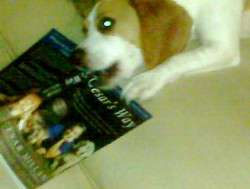 Kristin’s reponse:
Kristin’s reponse:
I am SO happy to hear that things continue to go well. See, you can do it!! I am proud of the work you’ve done with her and her happiness is something to savor…You deserve how good it feels to see her happiness.
Also, you are right that she should not be in her harness full time. Just put it on her for walks or when you are training her or need her under control (to and from the car, for example).
Thanks for the update!
-Kristin
The Petcast Interview
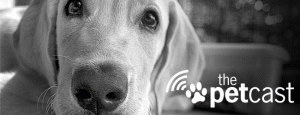 I was interviewed for a pet-oriented podcast called The Petcast by two very nice people (Steve & Emily) who wanted their listeners to learn more about fostering dogs. My interview is in Episode #193 titled The Dog Fosterer(!), available for MP3 download.
I was interviewed for a pet-oriented podcast called The Petcast by two very nice people (Steve & Emily) who wanted their listeners to learn more about fostering dogs. My interview is in Episode #193 titled The Dog Fosterer(!), available for MP3 download.
After the interview I had millions of things I wish I would have said. For one, I wish I would have said how DOABLE it is to foster a dog given the right mind set – it is work and more on the front end and easier as it goes on…opposite to raising a little of puppies who for the first two weeks literally nurse and sleep. They are no work at all – just a load of laundry twice a day and taking care of the mama. It is also important to understand some very basic things about dogs – they are social pack animals and assuming the foster dog had some positive experiences with people in her past
Dealing with Dog Aggression
 I’ve been thinking about aggression a lot lately. I have been reading a book by Stephen J. Joubert called Final Hope: Gaining Control of Your Aggressive Dog. I like this book because it is well organized. I also like how clear it is and how matter of fact it is. It has a section on how to identify whether or not you actually have an aggressive dog and chapters on what to do about each type of aggression – fear aggression, dominance aggression and dog aggression. I like the manner in which he frames the work as “going to war” because that is exactly how it feels. And I know. Believe it or not, one of my dogs is dog aggressive.
I’ve been thinking about aggression a lot lately. I have been reading a book by Stephen J. Joubert called Final Hope: Gaining Control of Your Aggressive Dog. I like this book because it is well organized. I also like how clear it is and how matter of fact it is. It has a section on how to identify whether or not you actually have an aggressive dog and chapters on what to do about each type of aggression – fear aggression, dominance aggression and dog aggression. I like the manner in which he frames the work as “going to war” because that is exactly how it feels. And I know. Believe it or not, one of my dogs is dog aggressive.
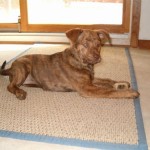 I obtained Lollie when she was about 8 weeks old, maybe more, maybe less. She was born around the first of December, 2004 to a mother who looked VERY Pit Bull-ish. She was part of a large litter who was born in a shed outside, moved to a shelter and lived in a cage for a while, separated from her mother then driven (for 2 days) up to Northern Illinois, and parked in a basement until I picked her and two of her littermates up to take to my house near the end of January. These were my first ever foster dogs. My beloved dog Sadie had died of lymphoma just three weeks prior to their arrival and I was still grieving big time. My heart had a huge hole in it and I knew it wasn’t a good time to get a dog but I wanted to fill that hole up so badly. I thought fostering would be a good idea – a way to give back and get back without getting in too deep when I was still missing Sadie so. Of the three of the pups, I knew Lollie was going to be a handful. She wasn’t as fearful as her litter mate Babe (who she would get into the nastiest of fights with) but she was demanding, obstinate, resistant, and smart, with a seemingly never ending supply of energy. High energy and high dominance is how I would characterize her now – then I just said, “She’s a handful!” I had a feeling that I was in for it when our first family came to look at the pups and I actively steered them away from her. I would look at her and get this feeling like it was out of my hands – we were going to be together forever. I also got a sense that she needed me and I am a sucker for that. I used to say, “Lollie, you are my Buddha.” She has taught me, through necessity, everything I know about dog training.
I obtained Lollie when she was about 8 weeks old, maybe more, maybe less. She was born around the first of December, 2004 to a mother who looked VERY Pit Bull-ish. She was part of a large litter who was born in a shed outside, moved to a shelter and lived in a cage for a while, separated from her mother then driven (for 2 days) up to Northern Illinois, and parked in a basement until I picked her and two of her littermates up to take to my house near the end of January. These were my first ever foster dogs. My beloved dog Sadie had died of lymphoma just three weeks prior to their arrival and I was still grieving big time. My heart had a huge hole in it and I knew it wasn’t a good time to get a dog but I wanted to fill that hole up so badly. I thought fostering would be a good idea – a way to give back and get back without getting in too deep when I was still missing Sadie so. Of the three of the pups, I knew Lollie was going to be a handful. She wasn’t as fearful as her litter mate Babe (who she would get into the nastiest of fights with) but she was demanding, obstinate, resistant, and smart, with a seemingly never ending supply of energy. High energy and high dominance is how I would characterize her now – then I just said, “She’s a handful!” I had a feeling that I was in for it when our first family came to look at the pups and I actively steered them away from her. I would look at her and get this feeling like it was out of my hands – we were going to be together forever. I also got a sense that she needed me and I am a sucker for that. I used to say, “Lollie, you are my Buddha.” She has taught me, through necessity, everything I know about dog training.
 I outline those early events in Lollie’s life because I used to look to them a lot for an explanation for her dog aggression. Nearly everyone I meet who sees her aggression says, “Oh is she a rescue?” and when I say yes they think that explains it. But she was so young when I got her; her aggression didn’t come from her past did it? Could her aggression be my fault? Those questions haunted me for so long. I have come to the conclusion that, yes, the disruption of her past and her uncertain breeding (could have been from fighting breed stock) are part of the reason she is dog aggressive. But I have come to the conclusion that I am also part of the reason she is dog aggressive. I was so new to dog handling back then and so, so very sad about Sadie. I just wanted to hold on and cry my eyes out and I used Lollie for that – she was supposed to comfort me, fill me up, make me forget my sadness, and take Sadie’s place; too tall an order for a little mongrel pup.
I outline those early events in Lollie’s life because I used to look to them a lot for an explanation for her dog aggression. Nearly everyone I meet who sees her aggression says, “Oh is she a rescue?” and when I say yes they think that explains it. But she was so young when I got her; her aggression didn’t come from her past did it? Could her aggression be my fault? Those questions haunted me for so long. I have come to the conclusion that, yes, the disruption of her past and her uncertain breeding (could have been from fighting breed stock) are part of the reason she is dog aggressive. But I have come to the conclusion that I am also part of the reason she is dog aggressive. I was so new to dog handling back then and so, so very sad about Sadie. I just wanted to hold on and cry my eyes out and I used Lollie for that – she was supposed to comfort me, fill me up, make me forget my sadness, and take Sadie’s place; too tall an order for a little mongrel pup.
 I was also afraid of her – she was part Pit Bull after all, and they are dangerous dogs, right? And even though I trained her well and early (she was the best behaved in her puppy class) and even though I socialized her well and early (we went to the dog park 5 times a week when she was a pup), I was still always afraid that I’d see aggression in her. And what did I eventually see? Of course I’m not saying that I made it happen with my thoughts or anything like that, but expecting to see aggression and fearing I’d see aggression clouded my ability to actually see what was going on with her and take appropriate steps. I can’t tell you the number of days that I would leave the dog park humiliated and ashamed telling myself, “she didn’t mean it, it was the other dog’s/person’s fault, it won’t happen again.” And some days it didn’t. She had some good doggy friends there and some people who really loved her. But most of the people who saw her, especially as she grew older, were afraid of her and would visibly withdraw from her. If I noticed that you can bet that she did too. At 6 months she began attacking dogs regularly and eventually I figured it out and stopped going to the dog park. I have been through the entire gamut of emotions about her aggression. Since it started so slowly I always feared it would keep getting worse. I became afraid for my son, strangers, kids we’d meet in the street. But she wasn’t aggressive in those settings. But put her with another dog, even one she has known for years, and she’ll try to attack. And it will happen so fast you won’t even see it coming.
I was also afraid of her – she was part Pit Bull after all, and they are dangerous dogs, right? And even though I trained her well and early (she was the best behaved in her puppy class) and even though I socialized her well and early (we went to the dog park 5 times a week when she was a pup), I was still always afraid that I’d see aggression in her. And what did I eventually see? Of course I’m not saying that I made it happen with my thoughts or anything like that, but expecting to see aggression and fearing I’d see aggression clouded my ability to actually see what was going on with her and take appropriate steps. I can’t tell you the number of days that I would leave the dog park humiliated and ashamed telling myself, “she didn’t mean it, it was the other dog’s/person’s fault, it won’t happen again.” And some days it didn’t. She had some good doggy friends there and some people who really loved her. But most of the people who saw her, especially as she grew older, were afraid of her and would visibly withdraw from her. If I noticed that you can bet that she did too. At 6 months she began attacking dogs regularly and eventually I figured it out and stopped going to the dog park. I have been through the entire gamut of emotions about her aggression. Since it started so slowly I always feared it would keep getting worse. I became afraid for my son, strangers, kids we’d meet in the street. But she wasn’t aggressive in those settings. But put her with another dog, even one she has known for years, and she’ll try to attack. And it will happen so fast you won’t even see it coming.
 I remember the day when I finally accepted her dog aggression. She was playing in the yard with a friend’s dog, Cocoa, one of Bella‘s pups that Lollie had known from puppyhood and had seen weekly for her entire life. I was upstairs looking out the window and saw Lollie in a dominant aggressive stance (tail up, hackles up, stiff legged, facing the dog, head lowered and growling) and I saw Cocoa give a perfect submissive stance (on her back, back leg up, head down and away, ears back). A normal dog will accept this complete submission, maybe rub it in by standing over the submissive dog and staring at it but a posture like that does not trigger a fight…usually. So I am watching this, Lollie above, Cocoa belly up, and I see Lollie lunge and bite Cocoa hard on the belly, repeatedly. Cocoa screams and Lollie keeps biting and Cocoa is struggling to get up and run away but Lollie keeps biting and by now I am screaming out the window and Lollie looks at me and Cocoa gets her feet under her and runs away and Lollie chases her and bites her again. By now I am in the yard (somehow, how did I get out there so fast?) and grab Lollie who goes all submissive on me but I ignore her and go to Cocoa and amazingly there is no blood. No blood? A definite wound, like you’d get if you were bit repeatedly without the skin being broken; swelling and bleeding under the skin but no broken skin. Spit all over her fur on her belly, neck, and back, but no blood. Thank god no blood. I am shaking just remembering it. It was that day that I decided that Lollie was not trustworthy with any dog.
I remember the day when I finally accepted her dog aggression. She was playing in the yard with a friend’s dog, Cocoa, one of Bella‘s pups that Lollie had known from puppyhood and had seen weekly for her entire life. I was upstairs looking out the window and saw Lollie in a dominant aggressive stance (tail up, hackles up, stiff legged, facing the dog, head lowered and growling) and I saw Cocoa give a perfect submissive stance (on her back, back leg up, head down and away, ears back). A normal dog will accept this complete submission, maybe rub it in by standing over the submissive dog and staring at it but a posture like that does not trigger a fight…usually. So I am watching this, Lollie above, Cocoa belly up, and I see Lollie lunge and bite Cocoa hard on the belly, repeatedly. Cocoa screams and Lollie keeps biting and Cocoa is struggling to get up and run away but Lollie keeps biting and by now I am screaming out the window and Lollie looks at me and Cocoa gets her feet under her and runs away and Lollie chases her and bites her again. By now I am in the yard (somehow, how did I get out there so fast?) and grab Lollie who goes all submissive on me but I ignore her and go to Cocoa and amazingly there is no blood. No blood? A definite wound, like you’d get if you were bit repeatedly without the skin being broken; swelling and bleeding under the skin but no broken skin. Spit all over her fur on her belly, neck, and back, but no blood. Thank god no blood. I am shaking just remembering it. It was that day that I decided that Lollie was not trustworthy with any dog.
 This made life difficult as by then we had acquired Bella and one of Bella’s pups, Hermes. And we also had Brandy, the old matriarch of the bunch who was with us when Sadie was alive. Lollie and Bella fought a lot in those early days and Bella took the worse of it. She suffered many attacks from Lollie and although they did not draw blood, she would often have long teeth scratches on her neck that you could see through her thick fur. I felt terribly responsible and confused as to what to do and began to hate Lollie for all this unpleasantness. Lollie also attacked Brandy a lot and these attacks sometimes drew blood when Lollie’s teeth caught Brandy’s soft ear flaps. As I write this I realize what I nightmare I lived through – sometimes we’d have a fight a day in the house. I didn’t let myself fully realize how out of control things were getting; I just keep reading and trying to figure it out. I went through a period where I wanted to get rid of her. Those rare times when she’d run off I was secretly relieved. I just didn’t want to deal with her aggressiveness anymore.
This made life difficult as by then we had acquired Bella and one of Bella’s pups, Hermes. And we also had Brandy, the old matriarch of the bunch who was with us when Sadie was alive. Lollie and Bella fought a lot in those early days and Bella took the worse of it. She suffered many attacks from Lollie and although they did not draw blood, she would often have long teeth scratches on her neck that you could see through her thick fur. I felt terribly responsible and confused as to what to do and began to hate Lollie for all this unpleasantness. Lollie also attacked Brandy a lot and these attacks sometimes drew blood when Lollie’s teeth caught Brandy’s soft ear flaps. As I write this I realize what I nightmare I lived through – sometimes we’d have a fight a day in the house. I didn’t let myself fully realize how out of control things were getting; I just keep reading and trying to figure it out. I went through a period where I wanted to get rid of her. Those rare times when she’d run off I was secretly relieved. I just didn’t want to deal with her aggressiveness anymore.
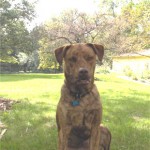 Around this time I learned of Cesar Millan and began watching his videos. I would stop and play back scenes that pertained to my struggles with Lollie, trying to find the key to solving this conflict. I began walking all my dogs, at the same time, as he suggested and that helped. I also began to fully understand that I am the alpha in the pack, not Lollie. She may take her position over the other dogs but I am the number one. And then someone told me something that really helped me – I am number one, Mike is number two, my son is number three and Lollie is number 23, Hermes is number 24, Bella 25 and Brandy 26. Lollie is SO far below me that she has no way of ever usurping me. I began to feel more confident with Lollie and less afraid. Actually, I began to get angry. “Enough is enough! I am through with you being aggressive! This is going to stop, NOW!”
Around this time I learned of Cesar Millan and began watching his videos. I would stop and play back scenes that pertained to my struggles with Lollie, trying to find the key to solving this conflict. I began walking all my dogs, at the same time, as he suggested and that helped. I also began to fully understand that I am the alpha in the pack, not Lollie. She may take her position over the other dogs but I am the number one. And then someone told me something that really helped me – I am number one, Mike is number two, my son is number three and Lollie is number 23, Hermes is number 24, Bella 25 and Brandy 26. Lollie is SO far below me that she has no way of ever usurping me. I began to feel more confident with Lollie and less afraid. Actually, I began to get angry. “Enough is enough! I am through with you being aggressive! This is going to stop, NOW!”
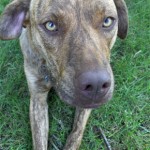 I kept up with Lollie’s obedience training throughout this time. I train with a great group called the Fox Valley Dog Training Club and at the club Lollie had to deal with a great number of on leash dogs in her space. I had a teacher that would work with me on her aggressiveness and I began to feel less ashamed and more confident. This was a problem my dog had and I was being a responsible dog owner by helping her work with it. It wasn’t an indictment about my worth as a dog owner. As her obedience skills improved and my confidence improved I began to be able to see her getting ready for an attack and block it. If I missed her cues and she lunged I would correct her with an “alpha roll” that I had trained her to do on voice command. I say “OVER” and she lies down and rolls to her side and puts her head down on the floor. She is to hold that position until I release her. Sometimes she’ll hold it for 45 minutes. It isn’t “cruel” she could go to sleep (and often does, when at home) in that position. It is a way I have to control her urge to be aggressive and communicate that I am in charge and I do not appreciate that sort of behavior. This has been my main communication tool. I have also gotten clear about what the rules of the house are and I enforce them 100%. Rule number one: NO aggression, that includes staring hard at another dog (Lollie’s early indicator of an attack) or growling. No taking other dog’s possessions (if you have it in your mouth it is yours unless I want it, then it is mine). No hassling other dogs (that includes pushing them off of a pillow you want or pushing them away from me), and no pulling on the leash when we walk. The rest of the rules are looser and I probably should enforce them more – no pushing past people on the stairs, no leaving or entering unless I say it is ok and then only after me and the other humans go first, no excessive barking, no chewing people stuff (toys, papers, garbage), no counter surfing (happy to say my dogs do not do this), and no jumping up on people (only Lollie does this, big surprise). There are probably more but I can’t think of them right now.
I kept up with Lollie’s obedience training throughout this time. I train with a great group called the Fox Valley Dog Training Club and at the club Lollie had to deal with a great number of on leash dogs in her space. I had a teacher that would work with me on her aggressiveness and I began to feel less ashamed and more confident. This was a problem my dog had and I was being a responsible dog owner by helping her work with it. It wasn’t an indictment about my worth as a dog owner. As her obedience skills improved and my confidence improved I began to be able to see her getting ready for an attack and block it. If I missed her cues and she lunged I would correct her with an “alpha roll” that I had trained her to do on voice command. I say “OVER” and she lies down and rolls to her side and puts her head down on the floor. She is to hold that position until I release her. Sometimes she’ll hold it for 45 minutes. It isn’t “cruel” she could go to sleep (and often does, when at home) in that position. It is a way I have to control her urge to be aggressive and communicate that I am in charge and I do not appreciate that sort of behavior. This has been my main communication tool. I have also gotten clear about what the rules of the house are and I enforce them 100%. Rule number one: NO aggression, that includes staring hard at another dog (Lollie’s early indicator of an attack) or growling. No taking other dog’s possessions (if you have it in your mouth it is yours unless I want it, then it is mine). No hassling other dogs (that includes pushing them off of a pillow you want or pushing them away from me), and no pulling on the leash when we walk. The rest of the rules are looser and I probably should enforce them more – no pushing past people on the stairs, no leaving or entering unless I say it is ok and then only after me and the other humans go first, no excessive barking, no chewing people stuff (toys, papers, garbage), no counter surfing (happy to say my dogs do not do this), and no jumping up on people (only Lollie does this, big surprise). There are probably more but I can’t think of them right now.
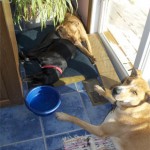 I write all this to give you a sense of what it is like to discover you have an aggressive dog and what it is like to come out the other side of this nightmare. Most dogs slowly reveal their aggressiveness. It is sort of something that builds over time. It is something that they learn. They try aggression and get what they want and are motivated to do it again. It is difficult to accept the truth of their aggressiveness because then you have to DO SOMETHING about it. I have thought long and hard about what to do about Lollie. I have even contemplated euthanizing her. In fact, I hold that option in my mind at all times. It actually helps me see her with more compassion – I literally hold her life in my hands. It helps me get into the mindset of being her steward and helps me take on the responsibility of being her owner. But we have found a way to work with her aggressive tendencies. Training and clear and consistent rules are a must. Daily structured exercise is a must. A daily pack walk for 2.5 miles minimum is a must, regardless of weather. Weekly training is a must. Strong leadership from me is a must. Blocking her aggression before it gets to an aggressive act is a must (and sometimes this requires her to be in a muzzle). Keeping my head clear, my emotions steady and my focus in the present is a must. With all of this I am happy to report that Lollie’s dog aggressiveness is under control. I would never say that she is “cured” and for the rest of her life I will not trust her with other dogs off leash. But I do walk her with my three other dogs and include my neighbor’s big female black lab, every day. And when we have fosters who aren’t dog aggressive I include them as well. Lollie will walk, with strange dogs just my two legs away from her, and behave herself. This is the biggest accomplishment I could have ever imagined and I am so proud of her and me for coming this far. So, if you have an aggressive dog, do not despair. But DO something. Face your part, get clear about her triggers and get help training her. And good luck.
I write all this to give you a sense of what it is like to discover you have an aggressive dog and what it is like to come out the other side of this nightmare. Most dogs slowly reveal their aggressiveness. It is sort of something that builds over time. It is something that they learn. They try aggression and get what they want and are motivated to do it again. It is difficult to accept the truth of their aggressiveness because then you have to DO SOMETHING about it. I have thought long and hard about what to do about Lollie. I have even contemplated euthanizing her. In fact, I hold that option in my mind at all times. It actually helps me see her with more compassion – I literally hold her life in my hands. It helps me get into the mindset of being her steward and helps me take on the responsibility of being her owner. But we have found a way to work with her aggressive tendencies. Training and clear and consistent rules are a must. Daily structured exercise is a must. A daily pack walk for 2.5 miles minimum is a must, regardless of weather. Weekly training is a must. Strong leadership from me is a must. Blocking her aggression before it gets to an aggressive act is a must (and sometimes this requires her to be in a muzzle). Keeping my head clear, my emotions steady and my focus in the present is a must. With all of this I am happy to report that Lollie’s dog aggressiveness is under control. I would never say that she is “cured” and for the rest of her life I will not trust her with other dogs off leash. But I do walk her with my three other dogs and include my neighbor’s big female black lab, every day. And when we have fosters who aren’t dog aggressive I include them as well. Lollie will walk, with strange dogs just my two legs away from her, and behave herself. This is the biggest accomplishment I could have ever imagined and I am so proud of her and me for coming this far. So, if you have an aggressive dog, do not despair. But DO something. Face your part, get clear about her triggers and get help training her. And good luck.
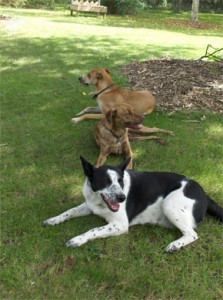
Hermes, Lollie & Bella all getting along...




